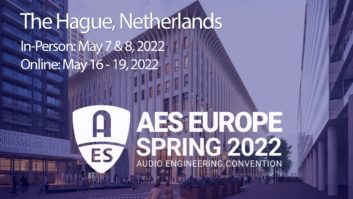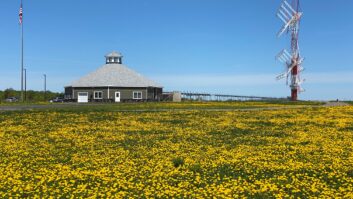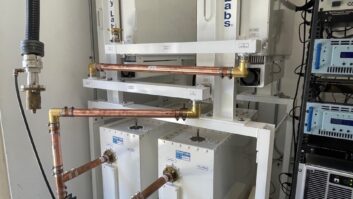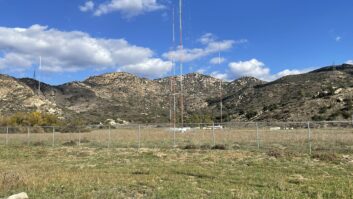
The DHD 52/SX console in Studio 1. Credit: Sandro Weltin (Council of Europe).
STRASBOURG, France — The Council of Europe was established in 1949 by the Treaty of London to face post-war political challenges and promote human rights.
Headquartered in a majestic building designed by architect Henry Bernard and finished in 1977, the international organization today brings together 800 million nationals from 47 member states in both Eastern and Western Europe.
PRESERVATION
The council recently began the digitization process of its voluminous archives. It also upgraded its multimedia studios. Paris-based systems integrations firm Eurocom Broadcast carried out the planning and incorporation of the new studios.
The Council of Europe’s archives constitute an irreplaceable collection, including many speeches delivered since 1949.
“We are working with our colleagues of the Council of Europe central archives to safeguard Europe’s history — preserving and digitizing this material is an essential task for future generations,” said Alun Drake, head of the organization’s audiovisual and multimedia service. The mission includes reviving forgotten speeches such as Sir Winston Churchill’s call for the construction of a United States of Europe as early as 1949, or those of Konrad Adenauer, or of the founding fathers of of contemporary united Europe, Robert Schuman and Paul Henri Spaak.

The control rooms are is built around DHD 52/SX consoles. Credit: Sandro Weltin (Council of Europe). “Who would have guessed that in the early 1950s a single European currency and a European army were already being contemplated? We have sound recordings from the original session of the Council of Europe in August 1949, which lasted one month,” Drake said.
The Council of Europe deals with a wide range of activities. Besides the protection of minorities and the combat against all forms of discrimination, it is also aimed to protect European cultural heritage. The Council of Europe Development Bank provides assistance to disaster victims, helps with job creation and puts in place projects to improve social infrastructure.

During the renovation process. Credit: Sandro Weltin (Council of Europe). DIGITIZATION
“With an average annual budget of €220 million, essentially funded by the member countries, one has to be extremely careful about safeguarding recordings, which were initially stored on big albums with an aluminum base before moving to taped recordings in the1960s,” said Drake. Sound engineer Ernst Ubelacker dedicates one week a month to the organization’s ongoing digitization process.
“Through this work, I have discovered little-known historic moments, as well as the technical peculiarities of those days such as the beginning of a speech recorded right in the middle of an album — or even at the end — and the strange juxtaposition of two speeches, each one engraved the other way around,” said Ubelacker.
Certain speeches stored on tape were damaged by humidity, recalls Ubelacker. One example is that of Mikhaïl Gorbatchev’s famous 1989 speech, audio of which they were miraculously able to save using video/tape transfer.
In a small room filled with sound archives at the Council of Europe, a rare EMT 927-ST turntable dating back to 1962 might catch your eye. Ubelacker uses that and another rare device: a Loricraft Audio cleaning system for pumping the dust out of the grooves of vinyl discs. “These old machines are precious to us,” said Ubelacker, pointing to an old tape recorder from Telefunken AEG.

The control room and multimedia studio. Credit: Sandro Weltin (Council of Europe). The Council has already produced a double CD, which includes 50 years of archives (and speeches from Sir Peter Smithers, Bruno Kreisky, Sandro Pertini, Tony Blair and Helmut Kohl, to mention a few) from 1949 to 1999.
UPGRADE
“Upgrading the studios was imperative to our digital transition,” said Drake. “We had to develop content for our website, due to the growing demands for video podcasts, and we dedicated one of the two radio studios to multimedia needs.”
“We needed to follow the technical tendency of commercial radio stations but to also ensure that other Council of Europe departments could benefit from this evolution,” Drake said. “Certain stations have recorded their programs in our studios; in particular, Prague-based Radio Free Europe (RFE/RL) and Turkish channel Sky Turk who used the studios for live broadcasts with guests via Skype.” Drake explains that the Council of Europe studios are there to serve the European audience and therefore it is a priority that they are used for more than simply the four annual Council of Europe parliamentary assemblies. The organization also uses the two studios for training and internal communication services.

Multimedia studio team, from left: Alun Drake, Mario Bertalmio, Ernst Ubelacker and Unai Garcia. Credit: Sandro Weltin (Council of Europe). Eurocom Broadcast installed all new gear within one week. “We changed just about everything — the display, the table, mics, cabling, monitors, cameras, consoles, even though we did leave some former material, and we really appreciated the quality of the work carried out by Bruno Guers, Eurocom Broadcast president and his staff,” said Mario Bertalmio, multimedia IT engineer in charge of the studios.
The furniture, racks and studio tables of each control room were all tailor-made and match the style of the rest of the Council of Europe headquarters. “We needed innovative and reliable products able to handle radio broadcasting associated with video, so we selected DHD 52/SX consoles for the control rooms,” said Guers.
The DHD 52/SX consoles are equipped with 16 faders, and monitor all local sources, the input from the studios and the input from the Council of Europe’s hemicycle (the large debating chamber for the organization’s parliamentary assembly). The desks also handle the equalization and dynamics processing.
The studios are also fitted with two speakers for monitoring, and Audio-Technica mics. External radio interviews from around the globe are all handled by an Orban codec.

The Council of Europe headquarters in Strasbourg, France. Credit: Sandro Weltin (Council of Europe). An Ethernet audio network carries the mic signals, headphones and logic controls to the DSP heart of the console via a cat-6 cable. Local sources (ISDN codec, CD driver, MD recorder, CF reader) are connected via Ethernet audio interfaces located in the control rooms, while output signals from the hemicycle are retrieved through a Soundweb processor.
One of the control rooms is designed for video production and houses three Panasonic HD turret cameras — one fixed, two mobile.
The radio/multimedia and the TV studios are located on two different floors. There is a dedicated cameraman for Web TV and reports and documentaries are transferred to the Council of Europe Web TV site. Video editing and encoding is done using a network of seven Mac units, connected to a server that stocks all the multimedia files.

Logo – The Council of Europe. Credit: Sandro Weltin (Council of Europe). The studios, of which the weekly occupation rate varies depending on the lineup of events, serve a variety of undertakings. Another section of the communications department manages blogs and social media, such as Twitter, in these multifunctional studios, for example.
“With ISDN, we can call people at home or in their office. We record outside interviews, we organize training and voiceover sessions in 26 different languages, including Chinese, which are then published on the respective websites,” said Bertalmio.
Thanks to the recently renovated facilities, the Council of Europe can now carry its voice further.
Emmanuelle Pautler reports on the industry for Radio World from Paris.












